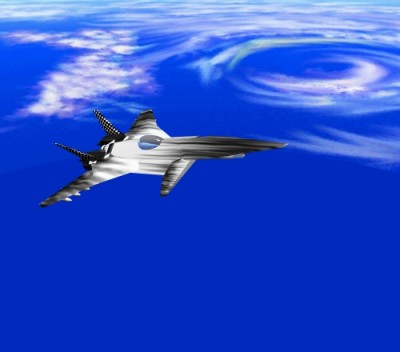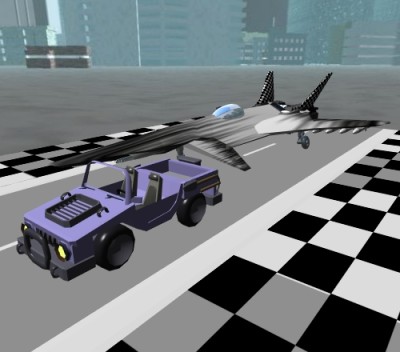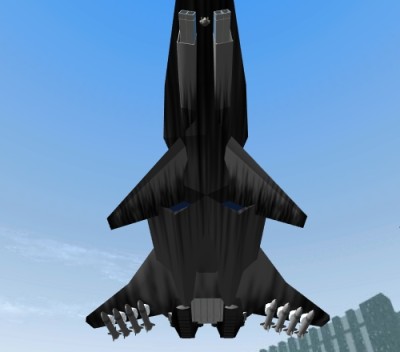Sidebar
Table of Contents
Wahoo Interceptor
Named after a fish notorious for being fast the lead designer of the Wahoo Interceptor claims it to be the quickest, most maneuverable starfighter in existence. While that has yet to be confirmed the YV1 Wahoo Interceptor is certainly a nimble fighter capable of the most intricate maneuvers. The reason it possesses such extreme swiftness is also its pilot's source of anxiety. The Wahoo has no armor. A pilot must rely on skill and finesse to bring down an enemy, landing shots without getting hit. This is a fighter for fast combat and as such is more suitable for making surgical strikes rather than fighting a war. It is legal for civilian ownership in both Yamataian and Nepleslian territory and supports Origin Starfighter Accessories.
History
As the Frontier Service Corporation's first production starfighter the YV1 'Wahoo' Interceptor was intended to make a splash. The design did not originate with FMS, but rather it is a redesigned version of a “paper plane” designed by an old aeronautics engineer during the second Mish war. It was never developed due to the extremely low demand for unarmored fighters during the height of the war, and due to the technology of the time it would have been a structurally fragile fighter with a short lifespan. FSCorp's Engineering team did not like the design either, however the old Engineer was a founding member of FMS and ultimately made the decision to begin designing the most maneuverable starfighter in history.
Getting test pilots for the early prototypes was nearly impossible after the first five attempts to takeoff had resulted in failure on the runway, with the first only traveling a meter before catching fire and the fifth actually making it airborne before losing a wing. FSCorp's refusal to abandon its “no drones” policy had cast a shadow over the project until meeting Crash, a fully robotic human who'd died many, many times and had made great use of android bodies. He was not a pilot but they didn't care, he was educated in a rush and the project resumed. Arthur “Crash” Teller earned his nickname after 12 failures, 3 resulting in his death. On the 13th launch the YV1x finally flew, making a safe flight over the airfield and landing safely, which would come to be called Crash's Flight. The team's fuel truck accidentally damaged the wing only minutes later but by then it didn't matter. Using the data collected during Crash's flight the design was completed mid YE 39 and production began.
About the Wahoo
Built purely to push the limits of star fighter performance, the YV1 Wahoo boasts impressive specifications in most STL aspects. While FTL performance leaves much to be desired future plans include detachable drones built specifically to assist the Wahoo in areas it lacks including FTL travel and defensive reinforcement.
| Wahoo Interceptor | |
|---|---|
| Class Overview | |
| Class | Fighter |
| Organization | Frontier Service Corporation |
| Manufaturer | Frontier Manufacturing Service |
| Nomenclature | Fs-YV1 |
| Designer | FMS Aerospace Division |
| Mission Specialization | Multi-role Interceptor |
| Price | 50,000 KS |
| General Characteristics | |
| Type | Superiority Fighter |
| Lifespan | 5 Years |
| Mass | 12,700 kg (12.7 Ton) |
| Length | 19 m |
| Width | 15 m |
| Height | 4.5 m (with landing gear down ) |
| Speed (Atmosphere) | Mach 5 |
| Speed (No Atmosphere) | .45c |
| Hyperspace Fold | 0.25ly/min |
| Crew | |
| Pilot | 1 |
| Defenses | |
| Hull Armor | 25 Armor Scale Structure Points |
| Shield Capacity | 25 Armor Scale Structure Points |
| Shield Threshold | 5 |
| Defenses | |
| Tier | 7, Mecha, Unarmored |
| Shield | Sphere |
| Detection | |
| Optical | Unlimited |
| Subspace | 1 LY |
| Thermal | Unlimited |
| Stealth | N/A |
Appearance
The Wahoo is very triangular in appearance with a narrow body and wide wings that sweep backwards, a pair of canards directly in front of both engine intakes small rudders, and two rudders at the top outer corners of the massive twin engines. Centrally located is a canopy with a reverse teardrop shape. It comes armed with four square-barreled Starfighter PLW's under the nose and four hardpoints beneath each wing. The fighter is made to order and is provided in virtually every color on the wheel.
Hardpoints / Weapon Systems
The Wahoo has four(4) slots for forward-facing weapons and eight( 8 ) wing hardpoints on which missiles, weapon pods, or additional systems can be mounted. The hardpoints and the equipment that can be held there are listed below.
The Wahoo can carry a lot of equipment, a feature made possible by the sturdy framework of its wings and the gravitic manipulation equipment within. However, the interceptor's claim to fame is its ability to outperform opponents through speed and maneuverability. Overloading it with heavy equipment has a dramatic effect on its dogfighting capabilities. In a Wahoo speed is life. A wise pilot capitalizes on lightweight loadouts or launches their payload as quickly as possible so that it may focus on dogfighting.
The wing hardpoints themselves are designed to be cross-compatible with the equipment of most popular brands of star fighter equipment. If it wasn't enough the engineers have also designed these hardpoints with the ability to detatch any payload at will. So if a rocket pod is empty it can be ejected to shed off dead weight. Perhaps the most creative use, or rather abuse, of the innovative hardpoints is the ability to mount weapons backwards. With no armor it is imperative that a pilot keep his rear view clear of hostile fighters and what better way to do that than surprise them with a missile? Why not a machine gun, or basically anything that fits?! Dedicating a hardpoint to a rear firing weapon is a fantastic way to dissuade pursuers! The possibilities are limited only by the imagination, however a list of suggested loadouts exist for those who prefer to simplify the process.
| Wing Hardpoints | x8 | Notes | |
|---|---|---|---|
| W3901 Recoiless Gravity Cannon | Heavy | ||
| W3901 RGC 30-round Ammunition pod | Heavy | ||
| Graviton Projector Pod | Heavy unless active | ||
| W3900 PLW Gunpod, Single | Light | ||
| Medium and light-duty OI equipment | Light, 1 hardpoint carries 2 light-duty items in pod | ||
| Wing Tip Hardpoinds | x2 | Notes | |
|---|---|---|---|
| W3900 PLW Gunpod, Single | Light | ||
| Loadout Template | |||
|---|---|---|---|
| Left Wing | Right Wing | ||
| Inner | OPEN | Inner | OPEN |
| 2nd | OPEN | 2nd | OPEN |
| 3rd | OPEN | 3rd | OPEN |
| Outer | OPEN | Outer | OPEN |
| Tip | OPEN | Tip | OPEN |
Armor Systems
The Wahoo is unarmored, however the craft is well-defended against EM radiation. (See Fuselage)
Onboard Systems Descriptions
The U-1 has standard sensor, life support, power and thrust systems. It is very durable but has few redundant systems to keep it in the fight after taking damage, often forcing it to retreat.
Computer
Like the U-1 production model, the Wahoo uses a cluster of datapads for computing power. This hardware comes with a suite of programming tools to help adjust the behavior of the Wahoo, setting systems to automatically deploy under certain conditions, automatically take defensive action, and generally assist with piloting and maintaining the craft. 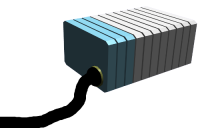
Additionally the Wahoo Interceptor has support for the Pilot Companion AI. It is the first craft specifically designed to host a PiCo copilot as the fighter's development inspired the Pilot Companion development as a result of being too intense in all respects to be flown without an AI capable of splitsecond timing. PiCo is particularly useful for automatically operating the rear-facing weapons, keeping shields where they need to be, and preventing collisions.
Fuselage / Internal Structure
The fuselage of the Wahoo Interceptor is made of a lightweight aluminum alloy. With the intention of appealing to the private sector the vessel has been designed to utilize less-lethal weapons, such as EMP missiles. To protect against failure during a 'danger close' maneuver the fuselage has Faraday shielding just beneath the titanium covering as a standard part of FSCorp's aerospace insulation method that arrests potentially dangerous electromagnetic radiation and channels it into the ship's power supply as electricity. As a result of this when a pilot is in a pinch he can quickly recharge his shields from the splash of EM weaponry, so long as they do not sustain a direct hit.
The airframe is made of titanium alloy, maximizing the weight reduction while maintaining the strength of the internal structure.
Under Damage Rating (Version 3), the Wahoo Interceptor is unarmored.
Cockpit
Beneath the optically correct, synthetic diamond canopy is the centrally located cockpit. The interceptor has amenities for a single pilot, with only the trainer version having capacity for 2.
The pilot is secured in an FMS Aerospace Seating System that can be built to the Pilot's specification. Whether the pilot chooses to wear power armor or a simple flight suit, a seating solution can be made to order.
The Wahoo deviates from the traditional HOTAS style controls in favor of a second joystick. When seated the right hand joystick controls pitch and roll. The pressure sensitive trigger operates the primary weapons on the nose of the ship, the further a pilots depresses the trigger the faster the guns will fire(up to each weapon's fastest RoF). The thumb button fires weapons mounted on the wings which must first be armed via a row of ten switches on the dashboard(8 points on wing, 2 on wingtips).
The left joystick controls lateral and vertical thrust while a dial for the thumb controls the main engines thrust(when dial is fully forward it can be depressed and pushed forward slightly to push the engines up to 110% output. THIS IS NOT SUSTAINABLE and engines will overheat if held more than 45 seconds). On the top of the joystick is a trackball for interfacing with the holographic interface.
The flaps can be engaged or disengaged by use of switches on the dashboard and are controlled automatically by the computer to ensure optimal performance without tearing off at high atmospheric speed. Also on the dashboard are switches for the landing gear, lights, and other related features. The artificial horizon and compass(both analog) only operate in a gravitational field and the clock must be set manually. It should also be noted that a PiCo may interact with any control on demand when plugged in and online.
Propulsion\Power Plant
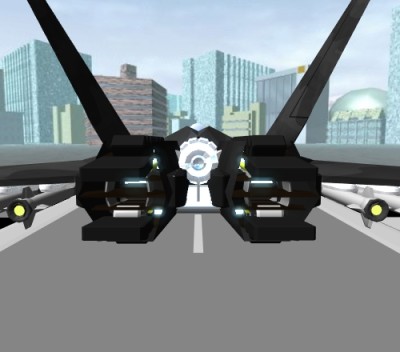 The Wahoo uses a pair of powerful FMS Gravity Engines for propulsion, power, and gravity manipulation. Weighing a little more than half the weight of the U-1 the Wahoo makes the most of its engines and also includes a series of inset RCS style thrusters and reaction control wheels to help with precision maneuvering.
The Wahoo uses a pair of powerful FMS Gravity Engines for propulsion, power, and gravity manipulation. Weighing a little more than half the weight of the U-1 the Wahoo makes the most of its engines and also includes a series of inset RCS style thrusters and reaction control wheels to help with precision maneuvering.
Life Support
The cockpit contains a Liquid Ally life support system under the chair in the cockpit. It is remotely controlled, and provides enough oxygen to support the pilot for about a month without needing to be cleaned / let out to play. The liquid allies are remotely controlled to provide an optimal environment for the crew, with oxygen and inert gasses adjusted accordingly to improve performance and alertness.
Sensors
The Wahoo Interceptor uses a subspace radar built into the nose to detect objects, exotic particles, and space-distortion at extreme range in a 270 degree arc infront of the craft. Small Optical and Thermal sensors equipped under the nose, between the cannons for a view underneath the craft.
Shields
A basic shield generator is installed along the spine of the craft, and generates a wide range electrostatic field that can slow and block projectiles as well as ward off harmful radiation. The Wahoo's engines are also used to generate a powerful gravity distortion field to help shield the craft against scalar attacks.
Being intended for hit-and-run attacks the shield has two hemispheres, forward and rear.
Countermeasures
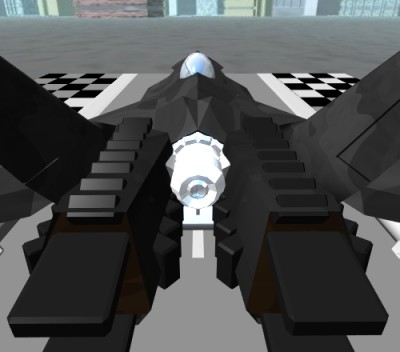 Naturally the Wahoo Interceptor will eventually be put in a situation where it is being pursued. To help this fighter survive those encounters where it is at a disadvantage a number of countermeasures have been equipped.
Naturally the Wahoo Interceptor will eventually be put in a situation where it is being pursued. To help this fighter survive those encounters where it is at a disadvantage a number of countermeasures have been equipped.
Each engine is equipped with a valve to feed in the same ingredients found in 80mm smoke screen submunitions. By using the engines thrust to disperse the smoke the craft can create an impressive field of smoke from behind it and each engine carries 30 seconds of smoke. A pursuing pilot would have great trouble trying to navigate through the smoke but drones and missiles would usually not have any issues. The metallic content of the smoke would also be hazardous toward atmospherically aspirated engines.
Between the two engines is a single, rear-facing weapon for warding off pursuing missiles or even pilots who follow too closely.
Standard Equipment
The cockpit contains the following equipment:
-
- First Aid Kit
- Liquid Ally Container.
- Modonafil Tablets
OOC Information
This page was approved on October 20, 2017 by Ametheliana.
Page Tools
Terms of Service - Privacy Policy

